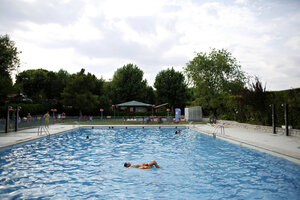After years of absence, tourists returning to Spain's summer getaways
Tourism to Spain has been on the decline since the economic crisis hit in 2008. This year, numbers appear to be rebounding.

A boy floats in a pool at a campground in the outskirts of Madrid earlier this month. After several years of contraction, Spain's tourism industry this year shows signs of recovery, as foreign visitors increase and Spaniards look to travel more domestically.
Juan Medina/Reuters
Cadalso de los Vidrios, Spain
In Cadalso de los Vidrios, an hour west of Madrid, the butcher shop is out of hamburgers, the community pool is packed, and finding a place to park is a pipe dream. And it's not even the weekend.
The town's busy summer is just one sign among many that Spain's getaways, restaurants, and attractions are recovering from years of painful consumer retraction, as both foreign and domestic tourists begin returning.
Tourist hot spots are roaring with activity ahead of next month's peak season, but most encouraging is the fact that not only Spain's famous Mediterranean beaches and its islands are filing up, but increasingly its more affordable inland destinations.
Tourism is vital to Spain, responsible for 12 percent of jobs and nearly 11 percent of its gross domestic product in 2012, a share that increased for a third consecutive year, according to the tourism survey of the National Statistics Institute.
A rough few years
But the economic downturn has hit hard. Tourism has been on the decline for several years straight, dropping again in 2012, albeit less than in previous years. Overall, tourism is still far from pre-crisis peaks, as Spanish residents continue to cut back on spending and foreign visitors only partially offset the declines in domestic travelers.
Tourism in 2012 was "bipolar," according to the annual report of the government’s Tourism Institute of Spain.
Foreign visitors increased from the previous year by 2.7 percent to 58 million, and they spent 56 billion euros ($74 billion), almost 6 percent more than the previous year. But the number of trips made by Spanish residents contracted by 1.2 percent.
Similarly, while overnight hotel stays by foreign guests increased by 2.4 percent in 2012, the overall number of stays dropped nearly 2 percentage points, thanks to an 8 percent decrease in local demand. Foreign guests accounted for roughly 65 percent of Spanish hotel stays.
The number of tourism-related jobs, meanwhile, decreased almost 1 percent in 2012, according to National Statistics Institute.
Rebound?
But this year, things appear to be picking up speed, even if the recovery is not complete. There are more foreign tourists who are spending more, while the drop in domestic tourism is starting to level off – and even show signs of growth in some segments.
Foreign tourism continues to be vital, increasing through May to nearly 20 million people – an almost 4 percent gain and the best five months since the peak 2008 season. May visitors alone increased more than 7 percent compared to May 2012.
The growth in 2013 has so far been led by Nordic countries, France, and Britain. Most tourists are British, French, and German. Americans make up 2.5 percent. While their numbers remain small, Russian tourists are also rapidly increasing.
Domestically, early 2013 tourism data indicates that residents are vacationing more than last year, when the recession hit especially hard. The bellwether hotels occupancy shows a mostly flat demand through May, compared to a drop in the same period in 2012.
Alternative to hotels
Meanwhile, both foreigners and locals increasingly prefer alternatives to hotels, especially rental apartments, in a crisis-born trend spreading wealth and job creation.
Non-hotel destinations are generally less expensive, all things considered. Additionally, more vacation rentals are being put on the market to make money from unused homes. And while still a small share, the number of rentals through web sites like Airbnb, which matches offers with demands from everything to a room or a sofa, to mansions, are growing skyrocketing as tourists seek cheaper alternatives.
Overnight stays in non-hotel destinations like rental apartments, campsites, and rural houses increased 2.4 percent in the first five months of 2013, led by a nearly 14 percent increase in May.
The increase was fueled by a 20 percent uptick in stays by foreigners and 2 percent improvement in stays by residents. Both had plummeted in the same period in 2012.

